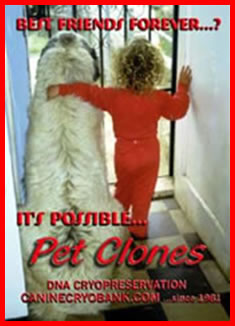![]()
New,
easy protocols for
preserving cells for future clones
A bull calf
clone, Galileo, born in Italy at Laboratoriodi Techologie della Riproduzione
under the direction of Dr.C. Galli, et al, is very important to all pet
owners because his conception started with frozen leukocytes from fresh
blood sample. Cats, dogs, horses, ferrets, llamas, any mammalian species
can be stored for future clones with this cryopreservation method. Due
to the remarkable simplicity of the cell harvesting and because early
results are so promising, researchers will closely monitor this method.
How
and When to Harvest Cells If an animal
is put down or dies suddenly and cells are to be harvested, DO NOT FREEZE
THE BODY! Refrigerate the body and call for the cell harvesting kit immediately.
The cell harvesting kits contain all information necessary to harvest
the cells and ship the cells in solution back to us. The total procedure took less than 8 minutes. The ice block method caused the dog's respiration to increase and the pupils to dilate, but the dog never raised his head nor did he try to move during either punch. Cells from this harvesting yielded cell cultures that successfully grew to fibroblast stage and were cryopreserved. Costs of Cell Harvesting |
Cryobank
Storage Available to Other Animals |
| Owners
of cats, rabbits, rats, mice, guinea pigs and other animals may have their
cells frozen for future cloning also. Laboratory animal species such as
mice, rats, rabbits, etc., will probably be successfully cloned before canines
and other animals because of the great need of their clones in the biotechnology
field. Horses, cattle, sheep, pigs, llamas, alpacas, and others may also have their cells processed and stored for future clone use. The livestock field is already providing clones such as the famous Dolly! |
Order Now: Canine Cryobank Cloning Kits
For human cloning information contact Human Cloning Foundation
